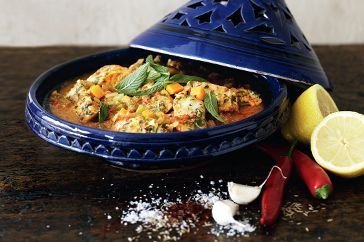How to Use a Moroccan Tagine: Origins, Culinary Uses, and 7 Tagine Recipe Ideas
Why Master It?
Tagine isn’t part of the codified French cuisine, nor is it something you’ll find at traditional French restaurants, either in France or abroad.
But given the estimated five million people of North African descent who live in France, and the excellence of the dish — soft chunks of meat, vegetables or a combination, deeply scented with spices and often lightly sweetened with fruit — it is no surprise that tagine has taken hold. A centerpiece of the chicest dinner parties, the dish exemplifies a modern wave of French home cooking, one that is exploring a host of diverse influences beyond the country’s usual repertoire.
Perhaps one reason the tagine has taken hold in France is that the dish is very similar to a French ragout, a slowly simmered stew of meat and vegetables. But while a ragout nearly always calls for a significant amount of wine (and often broth), to help braise the meat, a tagine needs very little additional liquid. This is because of the pot — also called a tagine — used to prepare the dish. With its tightfitting, cone-shaped lid, a tagine steams the stew as it cooks, catching the rising, aromatic vapor and allowing it to drip back over the ingredients, thereby bathing them in their own juices. (A Dutch oven with a tightfitting lid will accomplish nearly the same thing.)
The intensity of the spicing also sets the tagine apart from a ragout, which tends to use aromatics rather than ground spices for flavor. But a heady mix of spices, called ras el hanout, is at the heart of a good tagine. In North Africa, each cook traditionally makes his or her own often highly complex spice blend. In our tagine recipe, we use a very simple mixture of spices that are easy to find.
Cooks preparing a tagine usually strive for a balance of sweet and savory. That is why you see spices like ginger, cinnamon or clove used to bring out the sweetness of the meat, alongside braised fruit (apricots, prunes or raisins) and savory seasonings (parsley, pepper or saffron). The dish is usually served with flatbread for dipping in the complex and fragrant sauce.
